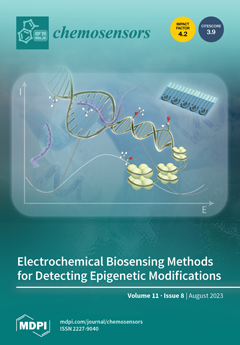Flexible substrates have known increased popularity over rigid ones due to their use in surface-enhanced Raman scattering (SERS). They provide irregular surfaces, ideal for in situ sensing. In this context, we report the SERS performance of hybrid ZnO@Ag thin films deposited by magnetron
[...] Read more.
Flexible substrates have known increased popularity over rigid ones due to their use in surface-enhanced Raman scattering (SERS). They provide irregular surfaces, ideal for in situ sensing. In this context, we report the SERS performance of hybrid ZnO@Ag thin films deposited by magnetron sputtering (MS) on flexible, thermoplastic substrates. This physical deposition method is acknowledged for obtaining high-quality and reproducible ZnO films that can be embedded in (bio)sensing devices with various applications. Three types of thermoplastic-based, commercially available substrates with different glass transition temperatures (T
g) were chosen for the variation in flexibility, transparency, and thickness. Zeonor
® (T
g = 136 °C, thickness of 188 μm) and two types of Topas (Topas
®: T
g = 142 °C, thickness of 176 μm; Topas2: T
g = 78 °C, thickness of 140 μm) thermoplastic sheets are nonpolar and amorphous cyclo-olefin polymer (COP) and cyclo-olefin copolymers (COC), respectively. Their thicknesses and different values of T
g can greatly affect the topographical and roughness properties of films with small thicknesses and, thus, can greatly influence the enhancement of the Raman signal. The ZnO films deposited on top of Zeonor
® or Topas
® have identical morphological properties, as shown by the scanning electron microscopy (SEM) characterization. Subsequently, by using the MS technique, we tuned the thickness of the deposited silver (Ag) films in the range of 7–30 nm to assess the growth influence on the morphology and the SERS signal amplification of the substrates with and without the ZnO intermediate layer. The SEM analysis showed that the Ag atoms migrated both into the interstitial areas, filling the voids between the ZnO granular structures, and over the latter, forming, in this case, isolated Ag clusters. SERS analysis performed on the ZnO-Ag hybrid films using crystal violet (CV) molecule revealed a limit of detection (LOD) of 10
−7 M in the case of 15 nm thick Ag/Zeonor
® interlayer films ZnO and relative standard deviation (RSD) below 10%.
Full article





